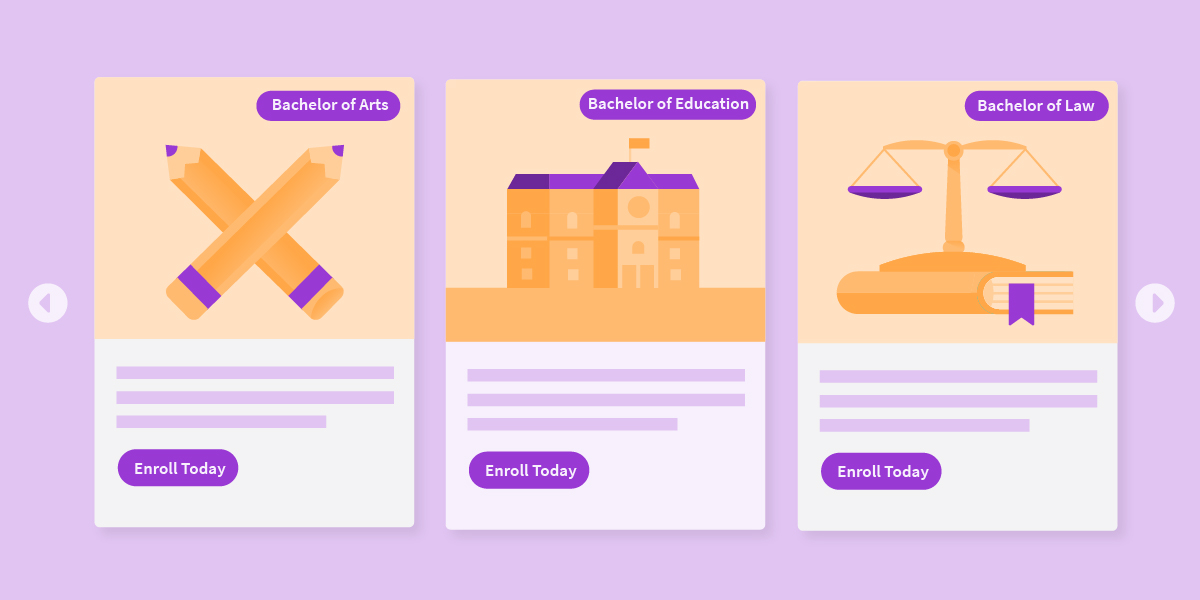College marketing is increasingly looking to leverage digital marketing strategies to increase brand awareness and enrollments. Through programmatic channels like connected TV (CTV) and programmatic audio, marketers can fill their enrollment funnel.
Below, we’re highlighting 4 ad creative formats that higher education marketers can use in their programmatic campaigns to reach their ideal audience.
Showcase Information With Rich Media Carousel Ads
Rich media carousel ads combine multiple ads into a carousel that users can swipe through. These ads capture your target audience’s attention helping to build awareness for your organization.
For a college marketing campaign, use a carousel ad to showcase between two and six programs, school details, or enrollment options. This is the ideal range because beyond six images, engagement can drop. By including several slides in a single ad unit, you’re able to appeal to a broader audience of prospective students.
Carousel ads are highly customizable with a number of options for navigation, frame transitions, timing, and more. For example, each slide can click out to a different landing page. From there, you can place pixels on your web pages to generate audience pools for retargeting purposes, or for future college marketing campaigns.
Here’s an example of a rich media college marketing carousel, a city macro is used to pull and call out the user’s geolocation. This adds a layer of personalization for your audience. You also have the option to include a state macro, enabling you to target the audience at a state level instead.
Engage Prospective Students With Rich Media Discovery Ads
With a discovery unit, you’re able to ask your audience questions and gain valuable insights. These are interactive ads that pose a question to the user. Their answers help you determine their interest or opinions, and clicks can be tracked to create retargeting pools.
You can leverage discovery ads to see if your audience is interested in learning more about student life, academic offerings, or collegiate sports. Users can respond using buttons, a checklist, or a dropdown menu, making the user experience interactive and engaging.
The users who interact with the ad can then be collected into retargeting pools based on their answer, enabling you to retarget them with the most relevant college marketing messaging.
Use Dynamic Countdown Ads to Create Urgency
Countdown ads can be leveraged to inform or remind prospective students about key dates for applying to a program or course. Not only is this ad format a practical method for informing students, but a dynamic countdown unit will help create a sense of urgency for prospective students to apply.
Consider adding an “Add to Calendar” button, which allows users to save the date directly from the ad to Google, iCal, Yahoo, or Windows Live. This can be leveraged as a prospecting tactic for tentpole events or activities, or add onto retargeting strategies to remind website visitors why they shouldn’t wait to apply to your program.
Create a Familiar User Experience With Social Units
Social display ads are a quick and easy way to reach new audiences utilizing social assets that you know are high performing. By leveraging this ad format, you’re able to unify your messaging across all platforms, which delivers a consistent and impactful experience to prospective students.
Extend your college marketing reach outside of the walled gardens while maintaining a familiar interface and experience to enable your audience to engage with these ads with confidence.
It’s recommended to offer a variety of social units. You’ll want to choose one that speaks to your audience demographics. For example, if you’re targeting an audience of students that are graduating from highschool, leverage TikTok to reach them.
Remember to Refresh Your Creatives Frequently
For college marketing, updating your ad creatives regularly is important. Your creatives should be program specific and should drive directly to the respective enrollment page. A specific creative tailored to each program, for example, will help achieve stronger performance results as opposed to driving user traffic to a college or university’s homepage.
Alternatively, you can consolidate your ad budgets and use an overarching creative that speaks to a variety of programs in an evergreen way, building awareness around the university brand name.
Remarketing to a similar audience in education campaigns, including recent accolades and university rankings, would lead to stronger engagement as rankings can influence an applicant’s decision. You can also target specific student concerns in your creative messaging, such as career outcomes, affordability, and feeling of fit.
Diversify Your Programmatic Channels For College Marketing Success
The college marketing audience is typically mobile-focused and pretty tech-savvy, making this audience a bit harder to pin down. These individuals gravitate to diverse digital platforms, and they should be able to find you there, too.
Introducing programmatic into your media mix does not mean you should abandon other channels. You should try to bridge all of the channels available to you through a multi-channel campaign.
Last, but not least, student journey mapping is key when it comes to college marketing. Student journey mapping enables you to determine when you should be prospecting, running campaigns, retargeting prospective students, and personalizing messaging. Ultimately, aligning your digital campaigns with student journey mapping will drive enrollments.
Want to run exceptional higher education campaigns? Request a demo to learn more about StackAdapt.
Find out how the Ohlmann Group leveraged the power of programmatic to sell out their student open house, here.





